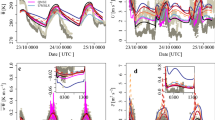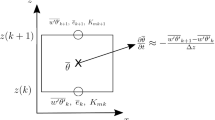Abstract
Recent upgrades to the boundary-layer scheme in the UK Met Office operational global Numerical Weather Prediction model are documented. These comprise a reduction in turbulent mixing in stable conditions over the sea, and the inclusion of non-local momentum mixing in convective conditions. The dependence of low-level winds on changing stability is shown to have been significantly improved. Crucially, it is also found that these improvements in local performance have been achieved without degrading the model skill in terms of synoptic evolution—something that has proved difficult to achieve in the past in many operational models. In fact some aspects of the large-scale flow (e.g. zonal mean winds) have been slightly improved.
Similar content being viewed by others
References
Beare RJ, MacVean MK, Holtslag AAM, Cuxart J, Esau I, Golaz J-C, Jimenez MA, Khairoutdinov M, Kosovic B, Lewellen D, Lund TS, Lundquist JK, McCabe A, Moene AF, Noh Y, Raasch S, Sullivan P (2006) An intercomparison of large-eddy simulations of the stable boundary layer. Boundary-Layer Meteorol 118: 247–272
Beljaars ACM, Viterbo P (1998) Role of the boundary layer in a numerical weather prediction model. In: Holtslag AAM, Duynkerke PG (eds) Clear and cloudy boundary layers. Royal Netherlands Academy of Arts and Sciences, Amsterdam, pp 287–304
Brown AR, Grant ALM (1997) Non-local mixing of momentum in the convective boundary layer. Boundary-Layer Meteorol 84: 1–22
Brown AR, Beljaars ACM, Hersbach H, Hollingsworth A, Miller M, Vasiljevic D (2005) Wind turning across the marine atmospheric boundary layer. Quart J Roy Meteorol Soc 131: 1233–1250
Brown AR, Beljaars ACM, Hersbach H (2006) Errors in parametrizations of convective boundary layer turbulent momentum mixing. Quart J Roy Meteorol Soc 132: 1859–1876
Candy B (2001) The assimilation of ambiguous scatterometer winds using a variational techniques: method and forecast impact. Forecasting Research Technical Report No. 349, Met Office, FitzRoy Road, Exeter, UK
Chelton DB, Freilich MH (2005) Scatterometer-based assessment of 10-m wind analyses from the operational ECMWF and NCEP numerical weather prediction models. Mon Wea Rev 133: 409–429
Cuxart J, Holtslag AAM, Beare RJ, Bazile E, Beljaars A, Cheng A, Conangla L, Ek M, Freedman F, Hamdi R, Kerstein A, Kitagawa H, Lenderink G, Lewellen D, Mailhot J, Mauritsen T, Perov V, Scheyes G, Steenveld G, Svensson G, Taylor P, Weng W, Wunsch S, Xu K (2004) Single-column model intercomparison for a stably stratified atmospheric boundary layer. Boundary-Layer Meteorol 118: 273–303
Edwards JM (2007) Oceanic latent heat fluxes: consistency with the atmospheric hydrological and energy cycles and GCM modelling. J Geophys Res 112: D06115, doi: 10.1029/2006JD007324
Frech M, Mahrt L (1995) A two-scale mixing formulation for the atmospheric boundary layer. Boundary-Layer Meteorol 73: 91–104
Keogh SJ, Offiler D (2006) SeaWinds revisited. Forecasting Research Technical Report No. 472, Met Office, FitzRoy Road, Exeter, UK
King JC, Connolley WM, Derbyshire SH (2001) Sensitivity of modelled Antarctic climate to surface and boundary-layer flux parametrizations. Quart J Roy Meteorol Soc 127: 779–794
Lock AP, Brown AR, Bush MR, Martin GM, Smith RNB (2000) A new boundary layer mixing scheme. Part I: Scheme description and single-column model tests. Mon Wea Rev 128: 3187–3199
Lorenc AC, Ballard SP, Bell RS, Ingleby NB, Andrews PL, Barker DM, Bray JR, Clayton AM, Dalby T, Li D, Payne TJ, Saunders FW (2000) The Met. Office global 3-dimensional variational data assimilation scheme. Quart J Roy Meteorol Soc 126: 2991–3012
Mahrt L (1987) Grid-averaged surface fluxes. Mon Wea Rev 115: 1550–1560
Martin GM, Ringer MA, Pope VD, Jones A, Dearden C, Hinton TJ (2006) The physical properties of the atmosphere in the new Hadley Centre Global Environmental Model (HadGEM1). Part I: Model description and global climatology. J Clim 19: 1274–1301
McCabe A, Brown AR (2007) The role of surface heterogeneity in modelling the stable boundary layer. Boundary-Layer Meteorol 122: 517–534
Rawlins F, Ballard SP, Bovis KJ, Clayton AM, Li D, Inverarity GW, Lorenc AC, Payne TJ (2007) The Met Office global 4-dimensional data assimilation system. Quart J Roy Meteorol Soc 133: 347–362
Viterbo P, Beljaars ACM, Mahouf J-f, Teixeira J (1999) The representation of soil moisture freezing and its impact on the stable boundary layer. Quart J Roy Meteorol Soc 125: 2401–2426
Wood N, Diamantakis M, Davies T (2007) A monotonically damping, second-order accurate, unconditionally stable, numerical scheme for diffusion An improved implicit predictor-corrector scheme for boundary layer vertical diffusion. Quart J Roy Meteorol Soc 133: 1559–1573
Author information
Authors and Affiliations
Corresponding author
Rights and permissions
About this article
Cite this article
Brown, A.R., Beare, R.J., Edwards, J.M. et al. Upgrades to the Boundary-Layer Scheme in the Met Office Numerical Weather Prediction Model. Boundary-Layer Meteorol 128, 117–132 (2008). https://doi.org/10.1007/s10546-008-9275-0
Received:
Accepted:
Published:
Issue Date:
DOI: https://doi.org/10.1007/s10546-008-9275-0




